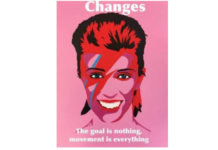In the around 35 years I worked for unions (over 30 with the Association of Salaried Medical Specialists and earlier with the New Zealand Educational Institute) I often cogitated over the distinction between unions and unionism. They are intertwined but not inseparable.
I associate unionism with collective consciousness able to lead to collective action usually, but not always, arising out of an employment relationship. The union is a structure within which this unionism is able to operate and organise.
Numbers, or more precisely density, are important for unions but membership empowerment within unions and at workplaces is unionism and more critical.
Central Otago, Helen Kelly and Karl Marx
You can have formal unions without unionism. These are, for example, unions that do enough for their members to generate a sufficient revenue stream or are employer created (or encouraged and facilitated) unions. Fortunately these types of unions are few.
However, the mentality behind them is wider. The current Council of Trade Unions President has worked with employers in the public health system to undermine the combative Resident Doctors Association by actively supporting a new competing employer-compliant union. The justification was that the RDA was not affiliated to the CTU. This reflected a narrow view of unions that has little to do with unionism.
It is also possible to have unionism without a union. I was struck by an academic article by Lloyd Carpenter published in 2013 in the Australian based Labour History under the revealing title “A Petty and Spiteful Spirit on the Part of the Company”: The 1881 Cromwell Company Strike at Bendigo, Otago. It involved a lengthy and bitter strike by employed miners.
The strike was eventually defeated because of the company’s power which it was willing to exercise in the most vicious manner. The power included owning the only available housing for the miners and their families. The viciousness was and then evicting them with the assistance of the severe central Otago winter.
But the strikers won the hearts and minds of the wider public, including in Dunedin, with favourable Otago Daily Times coverage and the company soon went out of business. What struck me the most was that there was no union. It was after all rural New Zealand in 1881.
The late Helen Kelly increasingly grasped the distinction between unions as structures and unionism as a dynamic when she was President of the Council of Trade Unions. For me this was most noteworthy with her campaigning over workplace safety in de-unionised forestry. Less prominent was her similar work in the likewise de-unionised agriculture sector.
Karl Marx’s fundamental observation on the nature of the working class also comes to mind. He distinguished between a ‘class of itself’ (its existence) and a ‘class for itself’ (its consciousness of being a class). The potential for the working class to be transformational would not be realisable when its development was restricted to the former. But, should it achieve the latter, this potential becomes realisable.
This Marxian insight prompted me to distinguish between ‘unions of themselves’ (structures) and ‘unions for themselves’ (unionism). It is the difference between unions as functional institutions and unionism as a movement.
NZNO external review
All these thoughts from central Otago to Karl Marx via Helen Kelly were in the back of my mind when I recently had the opportunity to read an external review of the performance of the New Zealand Nurses Organisation (NZNO). Completed on 2 November 2020 it covered the preceding 24 months.
The review followed a period of turmoil within NZNO which included internal conflict within its governing board and increasing membership dissatisfaction, particularly over its multi-employer collective agreement (MECA) negotiations with the 20 district health boards (DHBs). This dissatisfaction led to a number of membership resignations or non-renewals with a consequential sizeable financial hit.
NZNO is important for New Zealand’s health system. Realistically it is the only union of nurses. With around 51,000 members it is by far the largest number members working in the highly unionised public health system. This high membership leads to annual revenues of around $23 million which means, relative to other health unions at least, it is well-resourced with 131 full-time equivalent staff.
The NZNO Board discussed what were then proposed terms of reference for the external review on 1 July 2020. There was much confidence that the Board would come out well in the review with a senior leader stating that “…she wants the facts to speak for themselves and she believes that the way the Board has behaved has not been anything but reputable.”
The process for the review certainly gave the impression that it was structured to achieve this outcome. It was still being fine-tuned on 1 July but the review was completed and forwarded to the Board on 2 November; a short time period given the significance of the issues being considered. But this was achieved by confining those interviewed to a small number of current and past national leaders (elected and appointed).
There appears to have been no consideration of membership views as might be reflected through sessions with delegates, branch representatives or regional organisers. This is surprising given the high level of membership disquiet with its leadership including over the handling of the above MECA negotiations during the period under review.
Governance crisis
Despite this expressed confidence within the NZNO Board, the review did not conclude that its behaviour had not been anything but reputable. Instead its ‘hit-you-in-the-eye’ conclusion was that “NZNO is in a governance crisis.” It put responsibility for this crisis fairly and squarely on the shoulders of the Board, including because of internal conflict and regular breach of Board ethics. Lack of governance capability on the Board was also identified.
Senior staff were, on the other hand, commended. In fact, then chief executive Memo Musa is praised for his leadership including being described as the person holding NZNO leadership together.
Although undertaking the review was reported to NZNO members the Board excluded them from receiving it (inevitably, however, with the passage of time it has had some circulation beyond the Board). Only its recommendations were circulated to members but without the reasoning behind them. In other words, members were allowed to know what but not why.
The Board’s defence for excluding membership access is professional sensitivity and confidentiality. But there is nothing in the review that would justify exclusion. In this context professional sensitivity is a vacuous assertion. Confidentiality does not stack up as no critical comments about individuals are made and no confidential financial or personal information reported.
There is certainly embarrassment with its conclusion of a governance crisis and Board dysfunction. But embarrassment is no justification for making the review available for members who are NZNO’s main revenue stream and to whom the Board is electorally accountable.
Riddled with deficiencies
While the review’s conclusion of a governance crisis is reasonable its text is riddled with deficiencies. If you did not know that NZNO is a union you would not have learned this from the review. While the review does briefly acknowledge that NZNO is a registered union, it puts much more emphasis on it also being an incorporated society. But for a union to be registered under the Employment Relations Act being an incorporated society is a legal prerequisite.
The review is written as if it was applicable to any non-union incorporated society and looks to the Institute of Directors as the solution to many of NZNO’s problems. There is no consideration of membership accountability or the legal good faith obligations unions have to their members under the Employment Relations Act. Further, the Institute’s understanding of the role of unions is low.
Disappointingly the review simply concludes that if governance capabilities were resolved, NZNO’s problems including membership confidence would go away. It does not consider what the governance capabilities of a governing board of a union should be and whether the governance crisis was a consequence of growing membership dissatisfaction rather than its cause.
The choice of reviewers is indicative. They were a ‘leadership development manager’ at the Canterbury-based company Brannigans Human Capital Chris Bailey and commercial corporate lawyer Guy Royal. There is no suggestion of any experience of working in or with unions, particularly those representing professionals. What this contributes to is a review operating with only a limited context thereby missing more than it saw.
The deficiencies of the review stem from reliance on structural solutions to what is essentially relational and a lack of awareness of the role of NZNO as a union including membership accountability. It is as if NZNO is seen primarily as a professional body that includes some narrow union functions such as MECA bargaining.
There is a lack of a broad view of unionism that recognises the value of collectivist approaches to many issues including those that might be considered professional and industrial (in fact, there is a big area of blurry grey between the two).
The review considers the Board to have an “evident skills gap” and proposes outside expertise to be brought in. Among its recommendations to address this is that all Board members (‘directors’) must become members of the Institute of Directors and to remain eligible for another term have completed the Institute’s ‘essentials’ courses.
In doing so it fails to consider the kinds of skills that are needed for unions or other membership driven organisations. These skills are more to do with insightful understanding of the vulnerability, needs and aspirations of members. The Institute of Directors are not sufficiently experienced in this area. Technical skills such as financial literacy can be provided by external support or qualified senior staff (or both).
Reducing membership control
The review recommends major changes to the Board’s membership which require constitutional amendment. Under its constitution NZNO currently has a governing board comprising 11 elected members called directors. Designated director positions take up 4 of the 11 – President, Vice President, Kaiwhakahaere and Tumu whakarae (assists the Kaiwhakahaere). Members also elect the other 7 members.
If the review’s recommendations were adopted the size of the Board would be reduced from 11 to 9 directors. The above 4 designated positions would remain. But there would be a new unelected position created of Chair appointed by a three-person panel. The Chair could also be a non-member and would be additional to the 9 directors.
Two additional director positions would be created to “bridge the skills gap on the Board”. As with the Chair they could be non-members and would be selected by the same appointments panel. Realistically all 3 positions could be non-members.
The proposed unelected Chair of NZNO’s governing board is pivotal to the review. The role of the Chair is described as ensuring “…that discussion and decisions are centred at a strategic level as well as to take into account operations.” Further, the Chair needs “…to ensure the Board sets a culture that is maintained by the Board and driven through the organisation.”
No punches are pulled about the intent of the proposed Chair when it is called “…the most critical position of the organisation [NZNO]” as the holder works closely with the chief executive and Board. This suggests the review believes the unelected Chair sits above the elected President, Vice President, Kaiwhakahaere and Tumu whakarae!
Reducing the Board to 9 and requiring 2 of them to be appointed means that the number of members outside the above 4 designated positions dramatically reduces from 7 to 3. The effect would be a radical reduction in membership representation on the Board and consequential reduced members’ control and leadership accountability for a membership based organisation.
NZNO a union ‘of itself’ or ‘for itself’
NZNO’s recent successful negotiation of a new MECA for its DHB employed members in difficult circumstances was largely due to its learning from the previous internally fractious negotiation that contributed significantly to the decision to commission the review.
NZNO became more membership engaged and driven which had a big spin-off impact on the effectiveness of its collective bargaining. It was a powerful lesson in membership empowerment which began to move NZNO in the direction of the more influential position of being a ‘union for itself’.
This experience therefore makes the review’s recommendations so disappointing. The review is on a different planet to that of NZNO’s collective bargaining experience. The review goes in the opposite direction. If implemented effect of its recommendations would be to ensure that an organisation endeavouring to become more membership driven would instead become less accountable to its members than it currently is.
Recently NZNO has elected a new national president and vice president (Anne Daniels and Nano Tunnicliffe respectively). They stood as a ticket on a platform, building on the MECA negotiations experience, of strengthening NZNO as a membership-driven and empowered union. Ensuring that this review does not derail this direction will be a huge challenge for them.
How it responds to the review’s recommendations will be a test of the extent to which NZNO understands itself. Is NZNO a union and, if so, is it a union ‘of itself’ or ‘for itself’? How it responds will have wider implications for the union movement in the health system at least.
Ian Powell was Executive Director of the Association of Salaried Medical Specialists, the professional union representing senior doctors and dentists in New Zealand, for over 30 years, until December 2019. He is now a health systems, labour market, and political commentator living in the small river estuary community of Otaihanga (the place by the tide). First published at Democracy Project.





A ‘union’ with an unelected top management is not even a union ‘in itself’ let alone a union ‘for itself’.
A union that is ‘for itself’ has to be membership led, with elected delegates and management would be members, paid no more than the membership, accountable and recallable by the majority in a special general meeting.
indeed professional trade union managers are part of the problem. no knowledge of how their members actually live
This is the most insightful article about nursing unionism since my one last year (if I do say so myself).
NZNO will soon start consulting with members about changing the NZNO Constitution and making the organisation truly membership-driven. Ian Powell’s piece is incredibly valuable to inform that process.
https://thedailyblog.co.nz/2020/09/05/guest-blog-grant-brookes-whats-behind-the-turmoil-in-the-nurses-organisation/
Comments are closed.